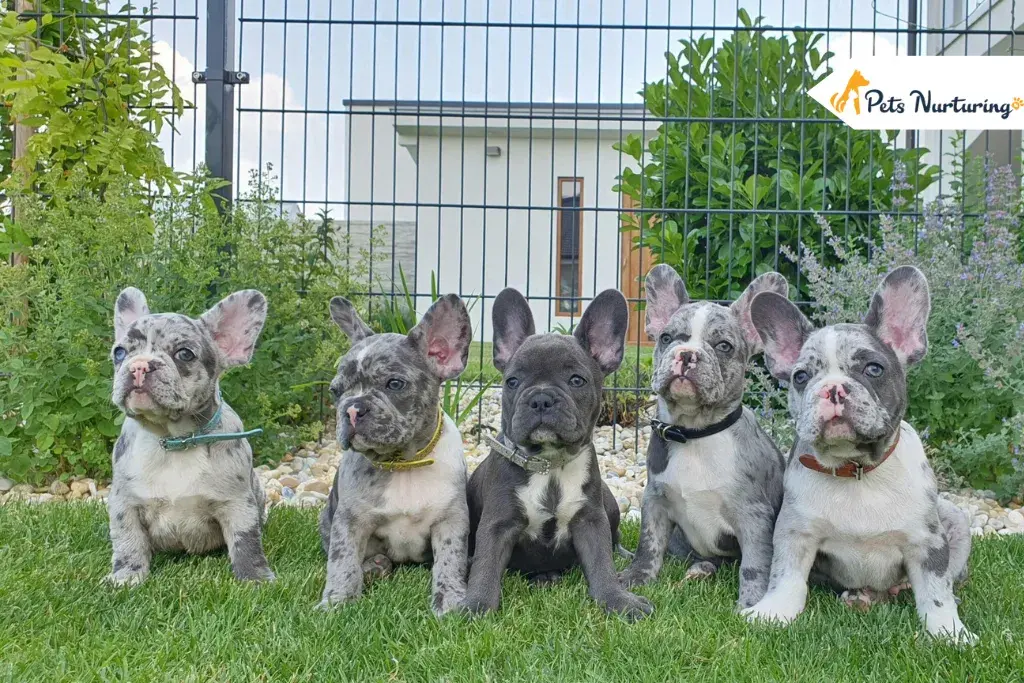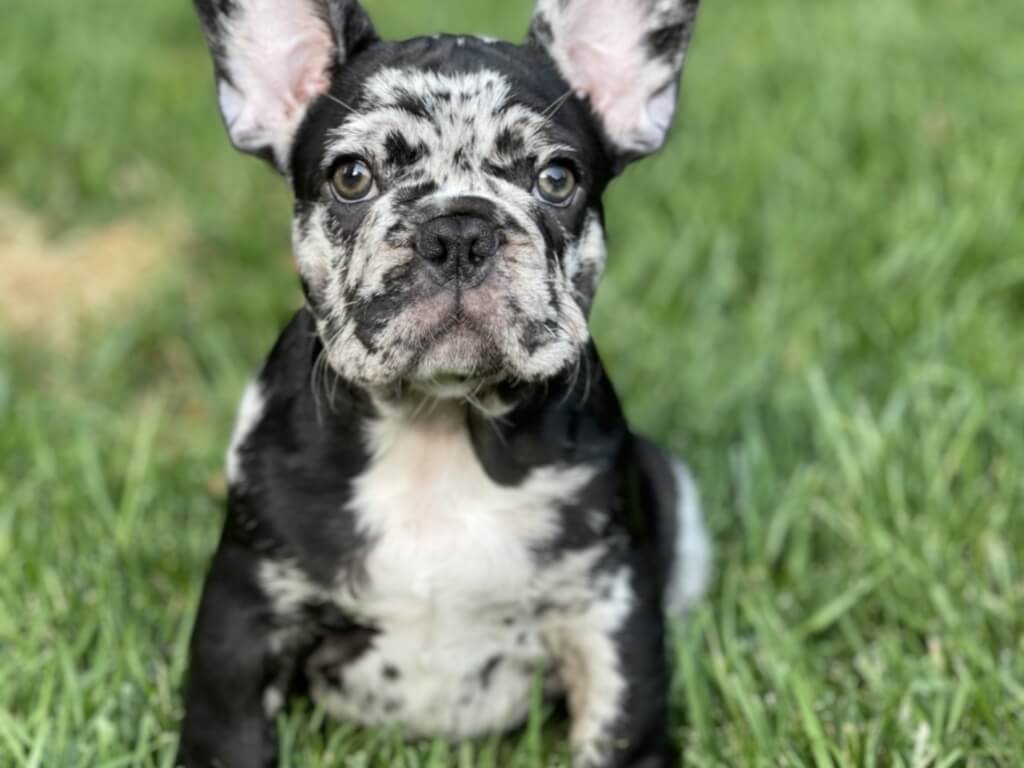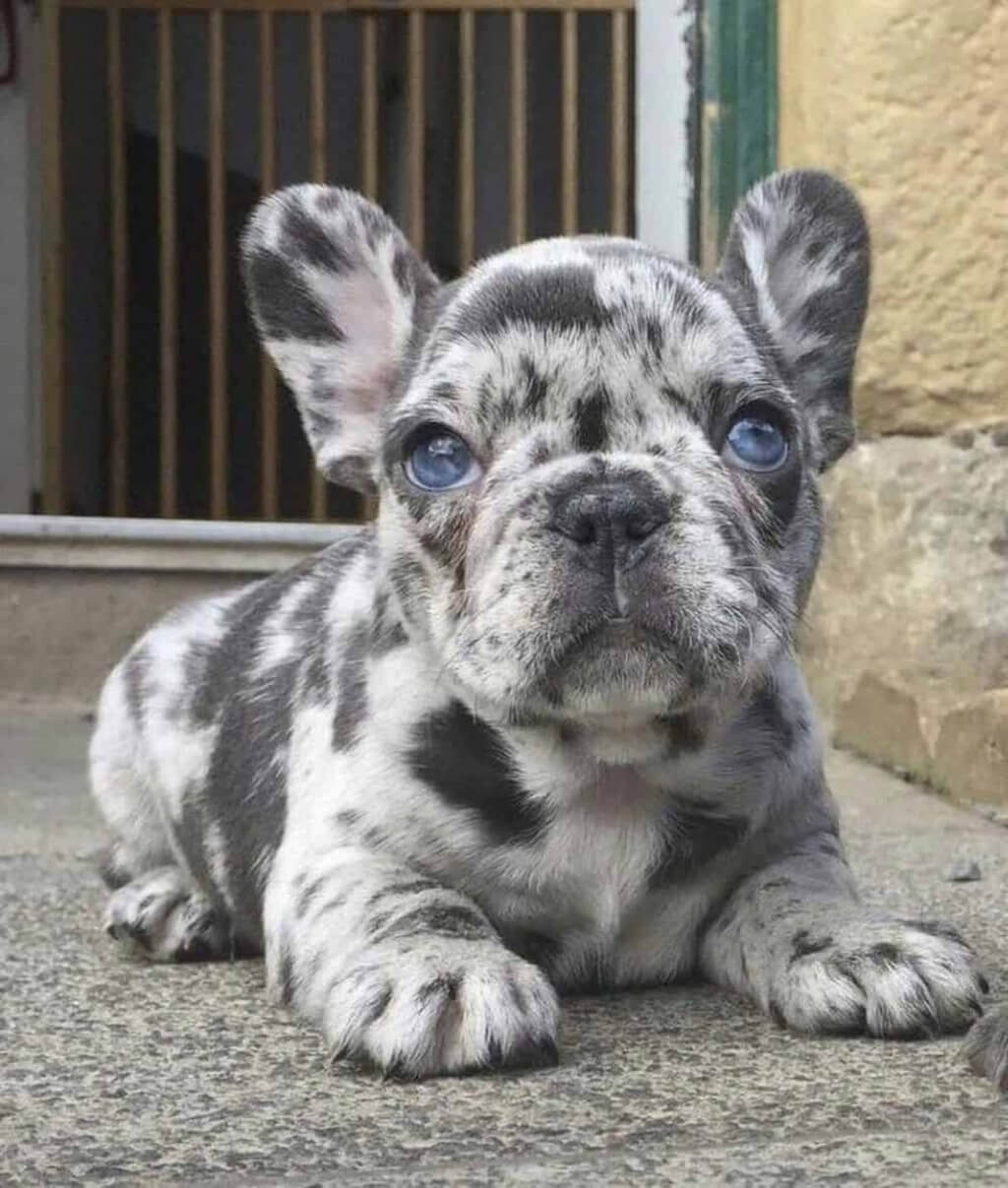
The Merle French Bulldog, though rare, continues to capture the hearts of people all over the world. With their diverse and beautifully colored coats, Merle French Bulldogs have all the same great features as any other colored French Bulldog, making many people eager to welcome a Merle French Bulldog into their home. They are adored not only for their stunning looks but also because of their fun-loving, affectionate, and happy personalities! Today, we’ll talk about the history of the breed, the appearance and genotype of the Merle French Bulldog, some common health concerns, grooming needs, and more.
- The Merle French Bulldog’s History
- The Appearance of the French Bulldog
- The Appearance of the Merle French Bulldog
- What is the Merle Genotype?
- Merle Frenchie: Common Health Concerns
- Merle Frenchie: Grooming
- How Much Exercise Does a Merle French Bulldog Need?
- The Merle Frenchie’s Personality
- Training a Merle French Bulldog
- Pricing: How Much Does a Merle French Bulldog Cost?
- The Merle French Bulldog
The Merle French Bulldog’s History
The history of the French Bulldog goes back to the early to mid-1800s, during the height of England’s Industrial Revolution. During this time, in Nottingham, England, many of what can only be described as toy-size Bulldogs were popular among lace makers.
The Industrial Revolution increasingly threatened the livelihoods of these lace makers, and they felt forced to move. Many ended up moving to the French countryside, where they would put their talents to good use. And, of course, they brought their little dogs with them!
It was here in the French countryside that these tiny bulldogs became increasingly popular. Over the decades, these bulldogs were bred to other breeds, like terriers and pugs. Once they were more established, they were given the name Bouledogue Francais.
French Bulldog’s popularity increasingly grew all across the world, except for England, of course, as they were too fond of their mascot, the Bulldog, to accept the French version!
The Appearance of the French Bulldog

The French Bulldog looks much like a Bulldog, except in a much smaller version! The breed is also known for its “bat ears.” They have a stout, small, but lean body, a very short nose, and muzzle and heavy wrinkles above their nose.
As far as coloring goes, the French Bulldog (according to the American Kennel Club) can come in brindle, white and brindle, cream, fawn, white and fawn, white and fawn brindle, white, and white and fawn. They can also have markings that can be described as ticked, white markings, black markings, black mask, piebald, and brindle markings.
The Appearance of the Merle French Bulldog
But what about the Merle French Bulldog? Exceedingly rare, the Merle French Bulldog is not recognized by the AKC. There is a good reason for this. The Merle French Bulldog actually isn’t a purebred French Bulldog! French Bulldogs are not natural carriers of the gene that creates that distinct and beautiful merle coat.
Instead, breeders have had to introduce another breed, like a merle Chihuahua into their breeding program in order to achieve this look. These pups are quite distinct and though rare, very easy to recognize! The base of their coat is often a light gray or tan color.
From there, the dog will have patches or splotches of color all over its body that range in color. There are Blue Merle French Bulldogs, Chocolate Merle French Bulldogs, and even Lilac Merle Frenchies. Many Merle French Bulldogs often have bright blue eyes, which is quite unusual for the breed itself!
French Bulldogs of any color typically have a similar appearance in that they weigh between 19 to 28 pounds and stand at about 11 to 13 inches tall at the withers. Their coat, though variable in color, is short and smooth.
What is the Merle Genotype?

Merle dogs of any breed, not just French Bulldogs, have the genotype Mm. This means that they have one merle allele (M) and one non-merle allele (m). A non-merle French bulldog has the genotype mm. When an Mm and mm are bred together, typical litters are half merle and half non-merle.
But what about French bulldog merle dog health? Are Merle French Bulldogs just as healthy as their counterparts? A common misconception is that they are not as healthy. In reality, the merle gene does not cause any health problems. However, health concerns do arise in cases where two Merle French Bulldogs are bred together, resulting in a double Merle French Bulldog.
Double Merles will often suffer from hearing loss and vision loss, among other health problems. In order to prevent this, a responsible breeder will never breed two merles together. Instead, to get healthy Merle puppies, a Merle French Bulldog must be bred with a solid-colored French Bulldog. To keep your dog healthy you can see tips.
Merle Frenchie: Common Health Concerns
One of the biggest health concerns for Merle French Bulldogs, or for any French Bulldog for that matter, is respiratory difficulties.
Because of the French Bulldog’s skull shape and facial features and that cute squished-in look they are famous for, they can have a harder time breathing than most dogs. This difficulty breathing is often diagnosed as Brachycephalic Syndrome or Brachycephalic Obstructive Airway Disease.
They also may be more prone to narrowed nostrils or elongated or soft palates, which can result in surgery being needed to help the dog breathe easier. You’ll often hear these dogs and dogs like them breathing heavily, especially in high heat or after strenuous exercise. They also are more likely to be noisy breathers in that they snort or snuffle frequently.
Additionally, they may be more likely to develop hip dysplasia, hemivertebrae (malformation of vertebrae), patellar luxation (a kneecap out of alignment), Von Willebrand’s disease (blood disorder affecting clotting, and intervertebral disc disease (disease affecting the spine). Regular vet visits will be necessary to ensure the health of the dog.
Merle Frenchie: Grooming

Since French Bulldogs are a short-haired breed, they don’t require an intensive or frequent groom. Instead, weekly brushing with a rubber curry brush should help remove their loose undercoat. They do tend to lose more of their undercoat in the spring and fall, so a de-shedding bath and extra brushing may be necessary during these times!
Grooming will also entail trimming your Merle Frenchie’s nails every two to three weeks to keep them nice and short so they don’t crack, split, or inhibit your pup’s ability to walk. Baths, especially de-shedding baths or moisturizing baths, can be great to help soothe any itchy skin. Don’t forget about regular ear cleaning! Here you can see how to groom a dog in detail.
Also, because of their wrinkles, dirt and other build-ups can accumulate on their faces, so using a damp cloth on their face and in their wrinkles will help keep them squeaky clean. Don’t forget to brush their teeth regularly.
How Much Exercise Does a Merle French Bulldog Need?
Merle French Bulldogs are considered a medium energy level breed, so while they aren’t lazy by any means, they may not be the best running partner either! Instead, several short walks around the neighborhood a day and a few good play sessions should be an adequate exercise for a Frenchie.
The breed itself is considered to be a brachycephalic dog, meaning that it has a short, wide skull that gives its face that distinct squished or pushed-in appearance they are so well known for.
Because French Bulldogs are brachycephalic, they are more prone to respiratory problems and don’t do well with intense exercise and heat, as breathing will become harder for them. So, if you prefer a brisk walk around the neighborhood rather than a grueling run through the countryside, this dog might be a perfect match for you.
The Merle Frenchie’s Personality

The Merle French Bulldog is a fun-loving, sweet, and overall great companion dog. They can be quite intelligent. They tend to bond heavily with one person, more so than others in the household, but they still love everybody. They thrive on attention and have quite a big personality for being such a small dog!
One trait that makes them a popular choice, especially among apartment dwellers, is that they rarely bark. Most only bark if they feel like they need to alert their family to a stranger’s presence outside of the home. Otherwise, they don’t often have much to say in the way of barking.
Training a Merle French Bulldog
Training often comes easily to these intelligent little pups. Some have even been quite successful at agility and obedience competitions! As long as you keep training fun and entertaining and as long as the pup thinks the reward you are offering is worth it, they’ll gladly comply with just about anything you ask!
However, they are known to have a bit of a stubborn streak and may give you a little bit of a hard time if they aren’t feeling motivated. In addition to their stubborn streak, they are also known for having an air of independence about them. Training recall early on will be important to keep the dog from wandering off and keep the dog safe.
Pricing: How Much Does a Merle French Bulldog Cost?
On average, some of the lowest prices for Merle French Bulldogs would be $4,990 and could go as high as $8,900, depending on the gender and coloring. Even Frenchie merle blue-eyed puppies cost more. Some say prices can vary between $7,000 and $20,000! While French Bulldogs are expensive to begin with, they are usually only anywhere from $1,500 to $3,000.
The Merle French Bulldog
The Merle French Bulldog is the perfect dog for just about anybody! They love having fun, playing, and being close to their humans. They often even get along great with all the other furry members of the household too!
If you want a stunning pup that adores spending time with its people and just wants to have fun, the Merle French Bulldog may be just right for you.
Continue reading :











